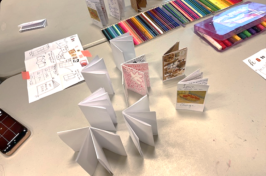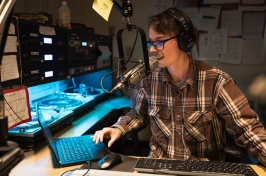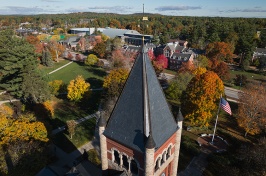UNH Student-Built Satellite will Blast into Space, Collects Data for NASA’s IMAP Mission

Sanjeev Mehta, a UNH research project engineer for the 3UCubed mission, inspects the CubeSat. Credit: UNH
DURHAM, N.H.—A multidisciplinary team of undergraduate students led by the University of New Hampshire designed and built a mini satellite, known as a CubeSat, that will launch into space to gather data in collaboration with NASA’s Interstellar Mapping and Acceleration Probe (IMAP) mission. The small-but-mighty satellite is set to launch on a SpaceX rocket from Vandenberg Space Force Base in California no earlier than Nov. 10, 2025 at 10:19 a.m. PST. It will head to the outer reaches of the atmosphere to study the solar wind which will help scientists in their quest to improve space weather forecasting and better protect technology in space and on Earth—such as communication networks, power grids and GPS—from potentially damaging large solar flare events.
“This is an amazing opportunity for UNH students to not only get hands-on technical experience but to also collaborate with other undergraduates across the country to design and build an entire space mission from the instrument to the software that will operate it in space and the antenna and radio to command the satellite once there,” said Noé Lugaz, research professor in physics and astronomy at the University of New Hampshire. “The experience is invaluable and can open doors to future opportunities in space-related or other science and engineering careers.”
A team of 70 undergraduate students from the University of New Hampshire (UNH), Sonoma State University (SSU) and Howard University (HU) designed, developed and built the satellite which was named 3UCubed—reflecting the overall concept of uplifting undergraduate students to study upwelling, and giving a nod to the three participating universities.
Selected as part of NASA’s CubeSat Launch Initiative, once it is launched, the satellite will travel to the Earth’s upper atmosphere, known as thermosphere, which is the same region where many other satellites and the International Space Station orbit around Earth. It will take measurements of the atmosphere density (single oxygen at this altitude) and electron precipitation from space onto the upper atmosphere, which can cause disturbances in communication signals and lead to changes in the ozone. Data from the mission will be collected by the students and analyzed in combination with data from IMAP and will help advance the understanding of how the thermosphere in the auroral and cusp regions responds to particle precipitation and varying conditions associated with solar wind.
CubeSats are a specific subset of satellites that are small and standardized and provide a cost-effective way to study space science. It is about the size of a loaf of bread and offers a simpler way to start building and operating than larger satellites, making it an ideal piece of equipment for students to hone their skills outside of the classroom.
The 3UCubed satellite was fully assembled at UNH and the two payload instruments that are a part of its structure were built, tested and calibrated at UNH. The students worked for five years on the satellite, performing a variety of tasks ranging from creating the software code that controls the 3UCubed to soldering the wires during the physical build. Students with mentorship from professors and staff engineers, performed trade studies, orbit analyses, selected vendors for different subsystems, oversaw budgets for various mass, power, link and telemetry jobs and developed the framework for the flight software and operations.
“At the time, I had a keen interest for the aerospace industry and saw this as a great opportunity to get valuable experience working with industry professionals,” said Alex Chesley ’22, who studied mechanical engineering at UNH and was a part of the 3UCubed mission team. “It was fascinating to learn about so many new subjects about space science and instrumentation that I had never studied before.”
The hands-on experience is meant to introduce, inspire and prepare students for a successful career in a related field like space science, computer science, engineering or science education. Chesley designed the initial CAD model of the satellite and also helped create the detailed specification list for the CubeSat’s altitude control system. He now works as a configuration engineer at STS Aerospace in Laconia, N.H., where he helps develop fluid distribution systems for customers in the space, aeronautics and defense industries.
“The experience with the 3UCubed mission helped with my professional growth, and it was definitely valuable to have, no matter what industry you end up working in,” said Chesley.
Students from UNH also took the lead in developing the instrument software and worked with students from SSU on the flight software. SSU oversaw the development of the software for the ground station and will serve as the primary ground station for the mission, which will collect the data from the satellite and will send commands to the spacecraft so it can adjust once it is in orbit. UNH worked with HU to build the back up ground station.
Students from Sonoma State University have also engaged with their region’s amateur radio operators and Scout members to construct a ground station for them to communicate with the satellite.
###
The University of New Hampshire inspires innovation and transforms lives in our state, nation and world. More than 15,000 students from 50 states and 87 countries engage with an award-winning faculty in top-ranked programs in business, engineering, law, health and human services, liberal arts and the sciences across more than 200 programs of study. A Carnegie Classification R1 institution, UNH partners with NASA, NOAA, NSF, and NIH, and received over $250 million in competitive external funding in FY24 to further explore and define the frontiers of land, sea and space.
PHOTOS FOR DOWNLOAD
Link: https://www.unh.edu/unhtoday/sites/default/files/img_2164.jpeg
Caption: Sanjeev Mehta, a UNH research project engineer for the 3UCubed mission, inspects the CubeSat during the integration at Maverick Space Systems lab in San Luis Obispo, CA.
Photo credit: UNH
Link: https://www.unh.edu/unhtoday/sites/default/files/20250725_165604780_ios_copy.jpg
Caption: Anthony Santo ’25, who majored in Computer Science at UNH, tested software for the 3UCubed mission’s CubeSat. He wrote code for the Instrument’s data collection and ground station operations.
Photo credit: UNH
Link: https://www.unh.edu/unhtoday/sites/default/files/20250725_165822393_ios_copy.jpg
Caption: The flight CubeSat for the 3UCubed mission being tested in a lab in UNH’s Morse Hall.
Photo credit: UNH
Link: https://www.unh.edu/unhtoday/sites/default/files/3ucubed_rendering_in_space.jpg
Caption: Rendering of CubeSat orbiting Earth.
Photo credit: UNH
Link: https://www.unh.edu/unhtoday/sites/default/files/3ucubedteam_credit_nasa_3ucubed.jpeg
Caption: Some of the 3UCubed mission team, with students, faculty and staff from the University of New Hampshire, Sonoma State University and Howard University, presenting at the American Geophysical Union annual meeting.
Photo credit: NASA 3UCubed
Latest News
-
November 26, 2025
-
November 6, 2025
-
November 5, 2025
-
October 24, 2025
-
October 8, 2025














































